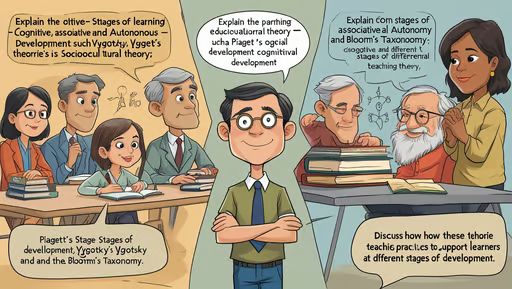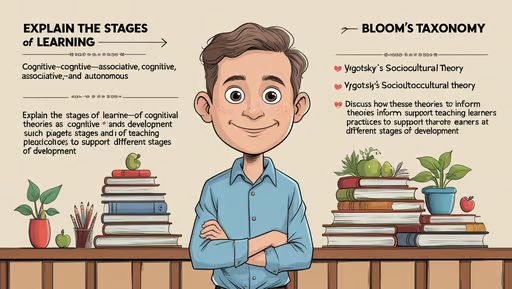Abstract
Stages of Learning and Their Theories in Education, Learning is a complex, multifaceted process that has been studied extensively in the field of education. Understanding the stages of learning and the theories that underpin them is crucial for educators to design effective teaching strategies and foster student development. This article explores the stages of learning, including cognitive, associative, and autonomous stages, and examines key theories such as Piaget’s stages of cognitive development, Vygotsky’s sociocultural theory, and Bloom’s taxonomy. By integrating these theories, educators can better support learners at different stages of their educational journey.
Introduction
Learning is a dynamic process that involves acquiring knowledge, skills, and attitudes through experience, study, or instruction. Over the years, educational psychologists and theorists have proposed various models to explain how individuals progress through different stages of learning. These stages are often characterized by distinct cognitive and behavioral changes, which are influenced by both internal and external factors. This article delves into the stages of learning and the theoretical frameworks that explain how individuals acquire and master new knowledge and skills.
Stages of Learning
The process of learning can be broadly categorized into three stages: the cognitive stage, the associative stage, and the autonomous stage. Each stage represents a different level of mastery and involves unique cognitive processes.
Cognitive Stage
The cognitive stage is the initial phase of learning, where the learner is introduced to new information or skills. At this stage, the learner focuses on understanding the task, identifying the key components, and developing a mental representation of the process. This stage is characterized by trial and error, as the learner experiments with different strategies to achieve the desired outcome.
For example, when learning to play the piano, a beginner must first understand the layout of the keys, the placement of fingers, and the basic principles of reading sheet music. Mistakes are common at this stage, as the learner is still developing a conceptual framework for the task.
Associative Stage
In the associative stage, the learner begins to refine their skills and reduce errors. This stage involves practicing the task repeatedly to strengthen the connections between the cognitive understanding and the physical execution. The learner starts to develop more efficient strategies and can perform the task with greater accuracy and consistency.
Continuing with the piano example, the learner at this stage can play simple melodies with fewer mistakes and begins to develop muscle memory for common chord progressions. Feedback and guidance from a teacher or mentor are crucial during this stage to correct errors and reinforce correct techniques.
Autonomous Stage
The autonomous stage represents the highest level of mastery, where the learner can perform the task effortlessly and automatically. At this stage, the skill has become second nature, and the learner can focus on higher-order aspects of the task, such as creativity and improvisation.
A pianist in the autonomous stage can play complex pieces with ease, interpret music emotionally, and even compose original works. This stage is marked by a high degree of fluency and adaptability, allowing the learner to apply their skills in diverse contexts.

Theories of Learning
Several theories have been proposed to explain how individuals progress through the stages of learning. These theories provide valuable insights into the cognitive, social, and emotional factors that influence learning.
Piaget’s Stages of Cognitive Development
Jean Piaget’s theory of cognitive development outlines four stages through which children progress as they develop their thinking and reasoning abilities: the sensorimotor stage, preoperational stage, concrete operational stage, and formal operational stage.
- Sensorimotor Stage (0–2 years): Infants learn through sensory experiences and motor actions. They develop object permanence and begin to understand cause and effect.
- Preoperational Stage (2–7 years): Children develop language and symbolic thinking but struggle with logical reasoning and perspective-taking.
- Concrete Operational Stage (7–11 years): Children gain the ability to think logically about concrete events and understand conservation.
- Formal Operational Stage (12+ years): Adolescents develop abstract thinking, hypothetical reasoning, and problem-solving skills.
Piaget’s theory emphasizes the importance of active learning and exploration, which aligns with the cognitive stage of learning.
Vygotsky’s Sociocultural Theory
Lev Vygotsky’s sociocultural theory highlights the role of social interaction and cultural tools in cognitive development. According to Vygotsky, learning occurs within the Zone of Proximal Development (ZPD), which is the gap between what a learner can do independently and what they can achieve with guidance from a more knowledgeable other (MKO).
Vygotsky’s theory underscores the importance of scaffolding, where teachers or peers provide support to help learners progress through the stages of learning. This theory is particularly relevant to the associative stage, where feedback and collaboration are essential for skill refinement.
Bloom’s Taxonomy
Benjamin Bloom’s taxonomy of educational objectives categorizes learning into six levels of cognitive complexity: remembering, understanding, applying, analyzing, evaluating, and creating.
- Remembering: Recalling facts and basic concepts.
- Understanding: Explaining ideas or concepts.
- Applying: Using information in new situations.
- Analyzing: Drawing connections among ideas.
- Evaluating: Justifying a decision or course of action.
- Creating: Producing new or original work.
Bloom’s taxonomy provides a framework for designing learning activities that align with the learner’s stage of development. For example, beginners may focus on remembering and understanding, while advanced learners engage in analyzing, evaluating, and creating.
Bruner’s Spiral Curriculum
Jerome Bruner’s spiral curriculum theory suggests that learning should be revisited at increasing levels of complexity over time. This approach aligns with the stages of learning, as it allows learners to build on prior knowledge and gradually achieve mastery. Bruner emphasizes the importance of active participation and discovery learning, which supports the transition from the cognitive to the autonomous stage.
Implications for Education
Understanding the stages of learning and the associated theories has significant implications for educational practice. Educators can use these insights to design instruction that meets the needs of learners at different stages of development.
- Differentiated Instruction: Tailoring teaching methods to accommodate the diverse needs and abilities of learners.
- Scaffolding: Providing temporary support to help learners achieve tasks they cannot yet complete independently.
- Formative Assessment: Using ongoing assessments to monitor progress and provide feedback during the associative stage.
- Encouraging Metacognition: Helping learners reflect on their thinking processes and develop self-regulation skills.
By integrating these strategies, educators can create a supportive learning environment that fosters growth and development across all stages of learning.
Conclusion
The stages of learning—cognitive, associative, and autonomous—provide a framework for understanding how individuals acquire and master new knowledge and skills. Theories such as Piaget’s stages of cognitive development, Vygotsky’s sociocultural theory, and Bloom’s taxonomy offer valuable insights into the cognitive, social, and emotional factors that influence learning. By applying these theories in educational practice, educators can design effective teaching strategies that support learners at every stage of their journey. Ultimately, a deeper understanding of the stages of learning and their underlying theories can empower educators to foster lifelong learning and development in their students.
References
- Piaget, J. (1952). The Origins of Intelligence in Children. New York: International Universities Press.
- Vygotsky, L. S. (1978). Mind in Society: The Development of Higher Psychological Processes. Cambridge, MA: Harvard University Press.
- Bloom, B. S. (1956). Taxonomy of Educational Objectives: The Classification of Educational Goals. New York: David McKay Company.
- Bruner, J. S. (1960). The Process of Education. Cambridge, MA: Harvard University Press.

3 thoughts on “Stages of Learning and Their Theories in Education”
Comments are closed.